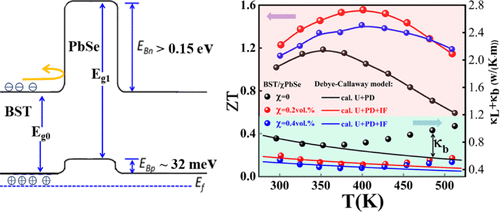当前位置:
X-MOL 学术
›
ACS Appl. Mater. Interfaces
›
论文详情
Our official English website, www.x-mol.net, welcomes your
feedback! (Note: you will need to create a separate account there.)
Achieving High Thermoelectric Performance in p-Type BST/PbSe Nanocomposites through the Scattering Engineering Strategy
ACS Applied Materials & Interfaces ( IF 8.3 ) Pub Date : 2020-09-30 , DOI: 10.1021/acsami.0c13542 Zhongsheng Jiang 1, 2 , Hongwei Ming 1, 2 , Xiaoying Qin 1 , Dan Feng 3, 4 , Jian Zhang 1 , Chunjun Song 1 , Di Li 1 , Hongxing Xin 1 , Juncai Li 1, 2 , Jiaqing He 3
ACS Applied Materials & Interfaces ( IF 8.3 ) Pub Date : 2020-09-30 , DOI: 10.1021/acsami.0c13542 Zhongsheng Jiang 1, 2 , Hongwei Ming 1, 2 , Xiaoying Qin 1 , Dan Feng 3, 4 , Jian Zhang 1 , Chunjun Song 1 , Di Li 1 , Hongxing Xin 1 , Juncai Li 1, 2 , Jiaqing He 3
Affiliation

|
To achieve high thermoelectric conversion efficiency in Bi0.4Sb1.6Te3 (BST) alloy is vital for its applications in low-grade energy harvesting. Here, we show that 56% increase in the power factor (PF) (from 16 to 25 μW cm–1 K–2) and 32% reduction of lattice thermal conductivity κL (from 0.56 to 0.38 W m–1 K–1) as well as an approximately four-fold decrease in bipolar-effect contribution κb (from 0.48 to 0.12 W m–1 K–1) can be achieved at 512 K through the incorporation of 0.2 vol % PbSe nanoparticles in the BST matrix. Analyses indicate that the remarkable increase in PF for the composite samples can be mainly attributed to strong electron scattering at the large interface barriers, inhibiting effectively the electron contribution to the total thermopower at elevated temperatures, while the large drop of κL and κb originates from enhanced phonon scattering by PbSe nanoinclusions as well as phase boundaries (among BST and PbSe nanophase) and suppression of electron transport, respectively. As a result, a maximum figure of merit (ZT) of 1.56 (at 400 K) and an average ZT (ZTave) of 1.44 in the temperature range of 300–512 K are reached. Correspondingly, a record projected conversion efficiency η = 11% is achieved at the cold side 300 K and hot side 512 K in the BST-based composite incorporated with 0.2 vol % PbSe nanoinclusions.
中文翻译:

通过散射工程策略在p型BST / PbSe纳米复合材料中实现高热电性能
在Bi 0.4 Sb 1.6 Te 3(BST)合金中实现高热电转换效率对其在低级能量收集中的应用至关重要。在这里,我们表明,56%的增加的功率因数(PF)(从16到25厘米μW -1 ķ -2)和%减少32晶格热导率κ的大号(0.56至0.38脉冲W M -1 ķ -1),以及在双极性效应贡献κ大约4倍的降低b(0.48〜0.12脉冲W M -1 ķ -1通过在BST基质中掺入0.2 vol%的PbSe纳米颗粒,可在512 K时达到)。分析表明,在PF的复合材料样品的显着增加可主要归因于强的电子散射在大的界面屏障,抑制在高温下的总热电有效的电子的贡献,而大滴κ的大号和κ b起源分别来自PbSe纳米夹杂物增强的声子散射以及相界(BST和PbSe纳米相之间)和电子传输的抑制。结果,最高品质因数(ZT)为1.56(在400 K时),平均ZT(ZT ave在300–512 K的温度范围内达到1.44)。相应地,在掺有0.2%(体积)PbSe纳米夹杂物的BST基复合材料中,冷侧300 K和热侧512 K达到了创纪录的预计转化效率η= 11%。
更新日期:2020-10-14
中文翻译:

通过散射工程策略在p型BST / PbSe纳米复合材料中实现高热电性能
在Bi 0.4 Sb 1.6 Te 3(BST)合金中实现高热电转换效率对其在低级能量收集中的应用至关重要。在这里,我们表明,56%的增加的功率因数(PF)(从16到25厘米μW -1 ķ -2)和%减少32晶格热导率κ的大号(0.56至0.38脉冲W M -1 ķ -1),以及在双极性效应贡献κ大约4倍的降低b(0.48〜0.12脉冲W M -1 ķ -1通过在BST基质中掺入0.2 vol%的PbSe纳米颗粒,可在512 K时达到)。分析表明,在PF的复合材料样品的显着增加可主要归因于强的电子散射在大的界面屏障,抑制在高温下的总热电有效的电子的贡献,而大滴κ的大号和κ b起源分别来自PbSe纳米夹杂物增强的声子散射以及相界(BST和PbSe纳米相之间)和电子传输的抑制。结果,最高品质因数(ZT)为1.56(在400 K时),平均ZT(ZT ave在300–512 K的温度范围内达到1.44)。相应地,在掺有0.2%(体积)PbSe纳米夹杂物的BST基复合材料中,冷侧300 K和热侧512 K达到了创纪录的预计转化效率η= 11%。













































 京公网安备 11010802027423号
京公网安备 11010802027423号